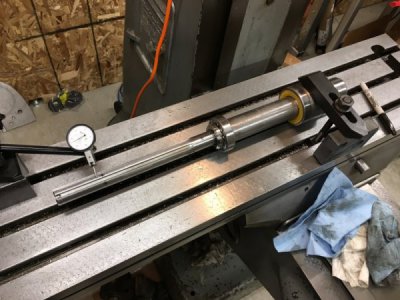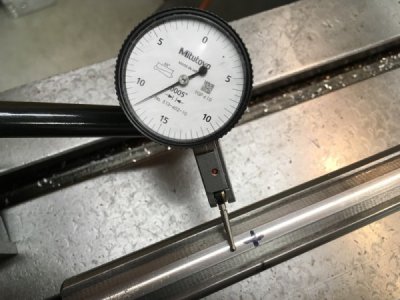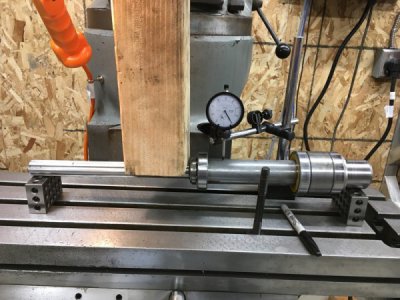Been very slow to update. Here is the end to this chapter in the story.
I pulled the spindle and checked the runout of the shaft by securing the thrust bearings to the table.

It was even more bent than I first thought. Found the shaft was running out about .018 at the top. The good news is it seemed to be a simple bend, not a compound bend. Could measure about .007 just above the upper bearing but the high/low sides were consistent down the shaft. If that makes sense.

Barry at H&W told me the shaft is really soft metal so I got the idea that I might try this setup below to straighten it vs. using a hydraulic press. I figured I could get more control. With the spindle shaft suspended between two 123 blocks, I used a piece of 4x4 against the ram & raised the knee with a dial indicator to monitor correction.

I started out real gently. Only putting about .025 deflection by raising the knee. Then re-clamp the thrust bearings to the table and measure runout. Didn't budge. Then I went to .050 still nothing. Then .075 and the runout dropped a couple thou. Continuing with .025 increments I got to .125 and all of a sudden it was gone. In fact I overshot it by a few thousandths so I just bumped it on the other side (about .050 deflection) and the shaft is now running less than .002 measured down the length. It appears I didn't introduce any compound bend (which I was concerned about).
Never done this before so maybe I was being obsessive about getting it true. Barry says he just hits it with a mallet. lol. My approach of using the knee & ram as a press like this might make some folks cringe. It really didn't take much pressure on the knee elevation crank to get the shaft to move.
The good news is I put it back in and the machine is MUCH quieter now and the quill moves up and down without feeling that rubbing from the spindle shaft. Now that the shaft vibration noise isn't so loud I could start to hear other noises at high speed. Most notably a growl in high range coming from play in the bull gear shaft/vari-speed pulley shaft cogs. I've played with adjusting the hi/low engagement lever stop to put a little more upward pressure in high range and that seemed to make it go away.
I know these vary-speed heads are not known to be quiet. The belt alone makes quite a lot of noise I'm sure. For now I'm very happy with how it's running. Again I don't have a lot of experience with these machines to know but to my ear it sounds very quiet at most working speeds.
Thanks again to Ted and others who provided advice. Maybe my experience with this might help someone else out. I didn't find much in any discussions about straightening a spindle when I researched this.
Now it's on to installing the 3-axis DRO that just arrived! Lots of good threads on that.






